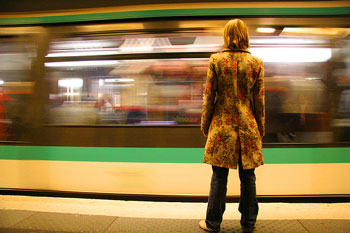Oftentimes, a long exposure (or slow shutter speed) is unintentional (it’s too dark, so your camera keeps the shutter open longer to compensate) and undesired (results in blurring, too much light, blurring, graininess, blurring). But you can use it to your advantage. Most cameras have a mode you can control shutter speed in, usually marked S or Tv. Don’t worry about anything else; the camera’ll take care of most of it. It’s quite straightforward: 1/200 is 1/200 of a second, for instance. 2 is two seconds. We’ll want something closer to the latter, but it all depends on the situation, and even then experimentation is the way to go.
Keep in mind that you will not want your camera to move, at all. Set it on a wall, in a tripod, on a box, suspend it from a banister if you must (though this is not recommended). Let’s proceed.
1) Traffic

It’s all about moving points of light blending all into one continuous stream. This works best at night, around twilight, any time of low light. Point your camera at the street, preferably not directly from the side/perpendicular to the traffic flow. We want to see headlights and taillights. Looking down at a busy overpass or road from above, if you can get it, may prove even more interesting. And there you are, a smooth river of red and/or white light, full of glow but strangely absent of car.
2) In Broad Daylight
 Smoothen out running water, blur a passing train or bustling crowd. It’s often more interesting if there’s a still subject somewhere in there, something or someone who does not move while everything else swirls all around. Panning is another option. Track the dog or the cyclist or the child across your frame of view. You are ideally somewhere off to the side of their line of movement, because you don’t want to worry about focusing on something far away and then close up. It would also help to not be barreled over. The subject will end up mostly clear while the background blurs away into abstract streaks. Trial and error is the key.
Smoothen out running water, blur a passing train or bustling crowd. It’s often more interesting if there’s a still subject somewhere in there, something or someone who does not move while everything else swirls all around. Panning is another option. Track the dog or the cyclist or the child across your frame of view. You are ideally somewhere off to the side of their line of movement, because you don’t want to worry about focusing on something far away and then close up. It would also help to not be barreled over. The subject will end up mostly clear while the background blurs away into abstract streaks. Trial and error is the key.
3) Snow
 Snow or sand is strangely reflectively bright at night, even without help of moon or streetlamp. Alternatively, try exposing moon-lit landscapes. It’s dim, but if you leave the shutter open for long enough a sufficient amount of light will get in there eventually. Again, avoid jostling the camera.
Snow or sand is strangely reflectively bright at night, even without help of moon or streetlamp. Alternatively, try exposing moon-lit landscapes. It’s dim, but if you leave the shutter open for long enough a sufficient amount of light will get in there eventually. Again, avoid jostling the camera.
4) Stars

You’ve probably seen startrails at one point or another. It features a graceful arc of stars sweeping across the sky. This involves leaving your shutter open for longer periods of time, like minutes or hours. Sometimes your camera’ll allow it, other other times not. If Bulb (shutter stays open until you tell it it’s done) is an option, this may be the time to experiment with it. Find dark areas with open sky and little light pollution, as even the smallest amount of light (from the lamp two streets down) might register and potentially blot out the dimmer stars. You will probably want a tripod. And a clear night.
5) Lightpainting
 Find a dark place. A room will suffice. Set your camera down and get in front of it (employ self-timer or a friend). Bring out the penlights and LEDs and the string lights from last Christmas. Pretty much anything will work, as long as it doesn’t give off too much light. Try different colors. Wave it around, draw pictures, plot out and follow precise diagrams (some people build extensive rigs with which to swing about their lights- it’s an art and a science). Do not fear trial and error; it is your friend.
Find a dark place. A room will suffice. Set your camera down and get in front of it (employ self-timer or a friend). Bring out the penlights and LEDs and the string lights from last Christmas. Pretty much anything will work, as long as it doesn’t give off too much light. Try different colors. Wave it around, draw pictures, plot out and follow precise diagrams (some people build extensive rigs with which to swing about their lights- it’s an art and a science). Do not fear trial and error; it is your friend.
And that’s all for this week on Fun Things to Do With Your Camera.


Leave a Reply
1 Comment on "Fun Things to Do With Your Camera: Long Exposure"